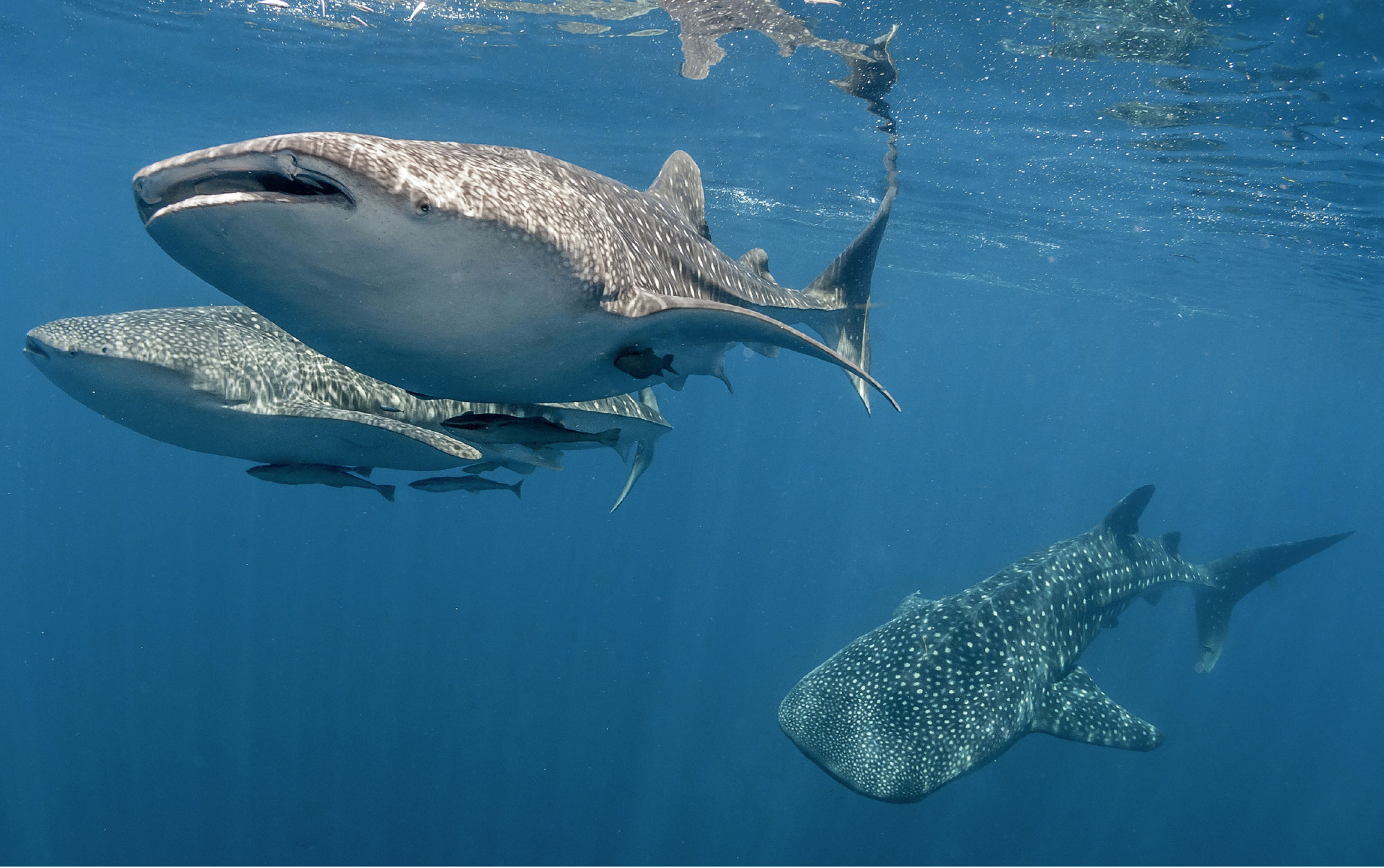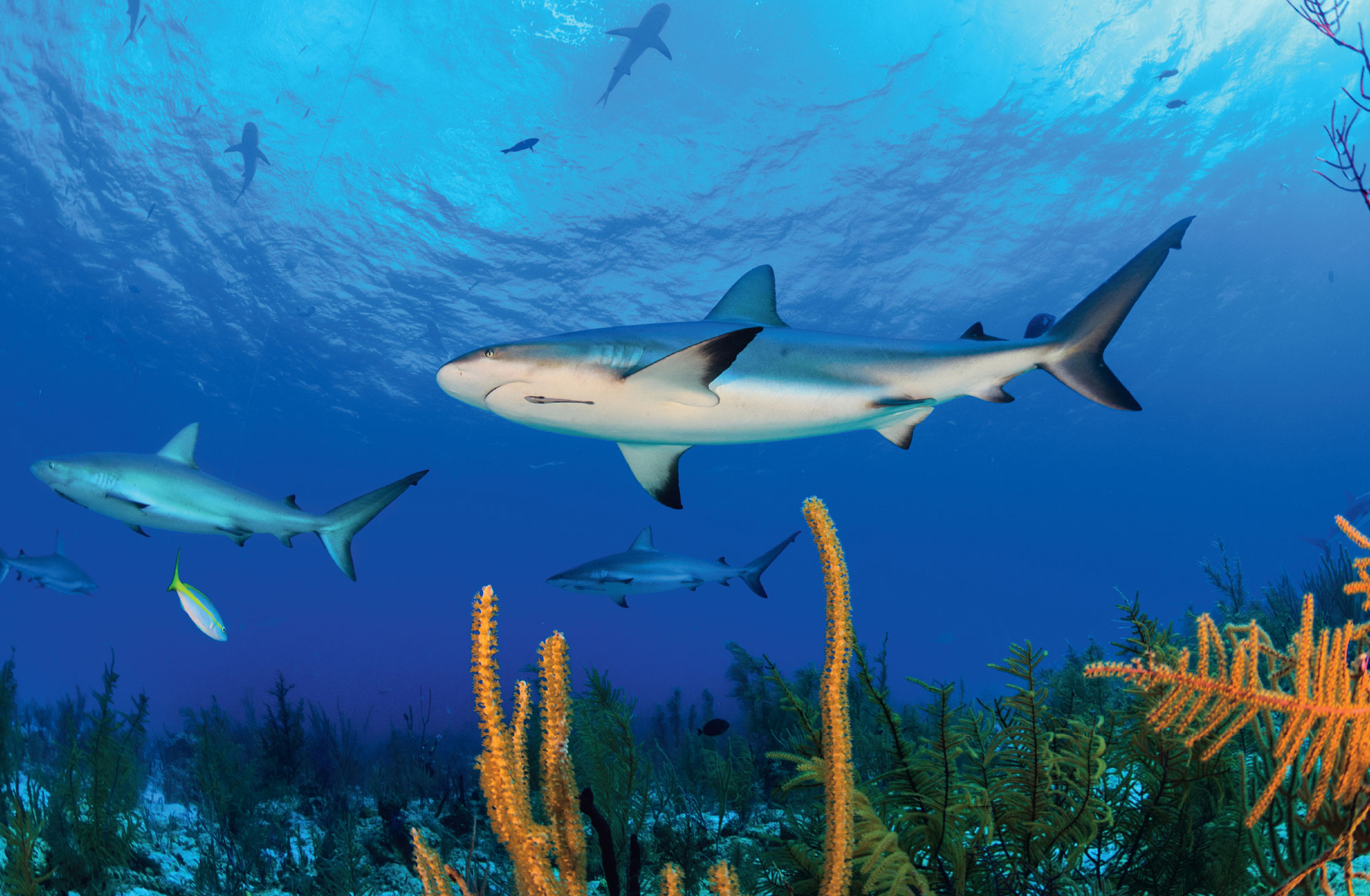Contents
Guide
SHARKS
THE OCEANS MIGHTIEST PREDATOR
JENNI ZELLNER

THE EVOLUTION OF A PREDATOR
DINOSAURS OF THE SEA
When most of us imagine a dinosaur, we think of a Tyrannosaurus rex, a Triceratops, or some kind of scaly beast that went extinct millions of years ago. While its true that most dinosaurs died out because of a bunch of natural disasters, some managed to survive by evolving and adapting to their environments. Those creatures are still among us today, and one of the oldest, most majestic, and most misunderstood species among them are the Chondrichthyesa class of cartilaginous fish that we call sharks.
Great White Shark
Whale Shark
Its important to remember that todays sharks arent actually dinosaurs, but their ancestors definitely were. Sharks bodies are made mostly of cartilage (the same kind of tissue thats in your ear), so they usually dont leave fossils behind in the same way that dinosaurs or other animals with bones do. Why? Because cartilage isnt very durable and degrades far more quickly than bone, so whats left are largely flattened fragments that cant be pieced together (if they can be identified at all). Its one of the primary reasons why scientists initially thought sharks werent as evolved as other marine species, because they couldnt find any fossil records!
Nurse Sharks
Shark Bites
The oldest shark teeth discovered can be traced back to the Early Devonian period (410 million years ago), which belonged to a prehistoric shark-like fish known as the Doliodus problematicus. However, these creatures werent true sharks in the way that we think of them today. Doliodus were shaped more like fish, but still had the defining characteristics of sharks, namely a cartilaginous skeleton and shark-like teeth.
So, how do we know how old sharks are? Unlike cartilage, shark teeth are made from bone and are capable of withstanding the test of time. Archaeologists have also been able to unearth fossilized skin scales called denticles, as well as vertebrae from ancient sharks. By comparing these remnants to fossils from dinosaurs, scientists have determined roughly when sharks lived and evolved. Through this process, the oldest evidence that we have of sharks are fossilized scales found in Siberia that are over 420 million years old.
Unfortunately, scientists have yet to discover shark teeth that date back quite as far, which is why many of them believe that early species of sharks may have actually been toothless! Its hard to imagine a shark without teeth, isnt it? But until more fossils are discovered, researchers will have to keep working to confirm this theory.
Great White Shark
Sharks have exsisted for over 400 million years, which means that theyve been around since before the Tyrannosaurus rex and Triceratopses roamed the earth!
Great Hammerhead Shark
Even without fossil evidence of the earliest sharks, scientists do know that they looked very different than they do now. This is because sharks, rays, and chimaeras (cartilaginous fish also called rabbit fish) are all part of the same Chondrichthyes classification. Most chimaeras split off into their own species by the Late Ordovician period (450 million years ago), which led to the evolution of the Cladoselache. Although scientists believe this creature is a descendent of chimeras, Cladoselache look the most similar to modern sharks due to their fins, forked tails, and torpedo-like bodies. Fossil evidence traces their origins to the middle of the Devonian period, which took place over 380 million years ago.
Pyjama Shark
THE GOLDEN AGE OF SHARKS
An extinction event at the end of the Devonian period resulted in over 75 percent of the species on Earth being wiped out. Many of those creatures were different kinds of fish, so their demise left space in the oceans ecosystem for sharks to dominate. That period of time, beginning 359 million years ago, is what scientists call the Carboniferous period, or the Golden Age of Sharks.
This dominance allowed a slew of unique shark species to thrive that might not have otherwise been able to in a more competitive environment. Some of these sharks had saw-like limbs that grew from the tops of their heads, such as the Falcatus falcatus; some had strangely shaped tails, like the Stethacanthus, whose tail was shaped like an anvil; and some even had teeth in odd places, like the Helicoprion, whose teeth grew in a circle like a buzzsaw. Needless to say, they looked pretty strange!
Sadly, these prehistoric sharks did not make it all the way to modern times. Around 251 million years ago, the most widespread extinction in Earths history occurred. Known as the PermianTriassic event, over 95 percent of Earths creatures were wiped out, leaving behind only a few shark and fish families.
Great White Shark
Whale Sharks
Caribbean Reef Sharks
This extinction ushered in the Jurassic period (most associated with the flourishing of dinosaurs) and later the Cretaceous period, by which point most animal ecosystems had recovered. By the mid-Cretaceous period (100 million years ago) sharks as we know them began to emerge, but there were still more changes to come. The CretaceousPaleogene extinction event came soon after and had one of the most significant impacts on shark evolution. While Lamniformes, an order of sharks made up of shark species such as the Great White and Mako, had been the dominant predator, the CretaceousPaleogene extinction wiped out many species within it, causing the order known as Carcharhiniformes to flourish instead. Comprised of sharks like the Hammerhead and Tiger, the Carcharhiniformes order made up a significant chunk of the sharks that survived the CretaceousPaleogene extinction. But while this extinction period was bad for the Lamniformes order, sharks overall were largely unaffected. In fact, 80 percent of all sharks survived, and thus the grandparents of todays sharks were born.























